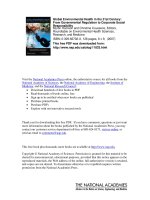Essentials of XBRL financial reporting in the 21st century by bryan
Bạn đang xem bản rút gọn của tài liệu. Xem và tải ngay bản đầy đủ của tài liệu tại đây (6.76 MB, 239 trang )
ESSENTIALS
of XBRL
Essentials Series
The Essentials Series was created for busy business advisory and corporate professionals.The books in this series were designed so that these
busy professionals can quickly acquire knowledge and skills in core
business areas.
Each book provides need-to-have fundamentals for those professionals who must:
• Get up to speed quickly, because they have been promoted
to a new position or have broadened their responsibility
scope
• Manage a new functional area
• Brush up on new developments in their area of
responsibility
• Add more value to their company or clients
Other books in this series include:
Essentials of Accounts Payable,
by Mary S. Schaeffer
Essentials of Capacity Management,
by Reginald Tomas Yu-Lee
Essentials of Cash Flow,
by H. A. Schaeffer Jr.
Essentials of Corporate Performance Measurement,
by George T. Friedlob, Lydia L. F. Schleifer, and
Franklin J. Plewa Jr.
Essentials of Cost Management,
by Joe and Catherine Stenzel
Essentials of CRM: A Guide to Customer
Relationship Management,
by Bryan Bergeron
Essentials of Credit, Collections, and Accounts Receivable,
by Mary S. Schaeffer
Essentials of Financial Analysis,
by George T. Friedlob and Lydia L. F. Schleifer
Essentials of Intellectual Property,
by Paul J. Lerner and Alexander I. Poltorak
Essentials of Knowledge Management,
by Bryan Bergeron
Essentials of Patents,
by Andy Gibbs and Bob DeMatteis
Essentials of Payroll Management and Accounting,
by Steven M. Bragg
Essentials of Shared Services,
by Bryan Bergeron
Essentials of Supply Chain Management,
by Michael Hugos
Essentials of Treasury and Cash Management,
by Michele Allman-Ward and James Sagner
Essentials of Trademarks and Unfair Competition,
by Dana Shilling
For more information on any of the above titles, please visit
www.wiley.com.
ESSENTIALS
of XBRL
Financial Repor ting
in the 21st Centur y
Bryan Bergeron
John Wiley & Sons, Inc.
Copyright © 2003 by John Wiley & Sons, Inc. All rights reserved.
Published by John Wiley & Sons, Inc., Hoboken, New Jersey
Published simultaneously in Canada
No part of this publication may be reproduced, stored in a retrieval system, or
transmitted in any form or by any means, electronic, mechanical, photocopying,
recording, scanning, or otherwise, except as permitted under Section 107 or
108 of the 1976 United States Copyright Act, without either the prior written
permission of the Publisher, or authorization through payment of the appropriate
per-copy fee to the Copyright Clearance Center, Inc., 222 Rosewood Drive,
Danvers, MA 01923, 978-750-8400, fax 978-750-4470, or on the web at
www.copyright.com. Requests to the Publisher for permission should be addressed to
the Permissions Department, John Wiley & Sons, Inc., 111 River Street, Hoboken,
NJ 07030, 201-748-6011, fax 201-748-6008, e-mail:
Limit of Liability/Disclaimer of Warranty:While the publisher and author have
used their best efforts in preparing this book, they make no representations or
warranties with respect to the accuracy or completeness of the contents of this
book and specifically disclaim any implied warranties of merchantability or fitness for a particular purpose. No warranty may be created or extended by sales
representatives or written sales materials.The advice and strategies contained
herein may not be suitable for your situation.You should consult with a professional where appropriate. Neither the publisher nor author shall be liable for any
loss of profit or any other commercial damages, including but not limited to special, incidental, consequential, or other damages.
For general information on our other products and services, or technical support,
please contact our Customer Care Department within the United States at
800-762-2974, outside the United States at 317-572-3993 or fax 317-572-4002.
Wiley also publishes its books in a variety of electronic formats. Some content
that appears in print may not be available in electronic books.
For more information about Wiley products, visit our web site at www.wiley.com.
Library of Congress Cataloging-in-Publication Data
Bergeron, Bryan P.
Essentials of XBRL : financial reporting in the 21st century / Bryan
Bergeron.
p. cm. — (Essentials series)
Includes index.
ISBN 0-471-22077-9 (pbk. : alk. paper)
1. XBRL (Document markup language) 2. Business
enterprises—Finance—Data processing. I. Title: Financial reporting in
the 21st century. II. Title. III. Series.
HF5548.5.X25B47 2003
005.7′2—dc21
2003006642
Printed in the United States of America
10 9 8 7 6 5 4 3 2 1
To Miriam Goodman
Contents
Preface
xi
1
Overview
1
2
Opportunities
29
3
Standards
53
4
Process
79
5
Technology
101
6
Solutions
129
7
Economics
157
8
Are We There Yet?
179
Glossary
203
Further Reading
209
Index
211
ix
Preface
ssentials of XBRL: Financial Reporting in the 21st Century is a practical survey of the extensible business reporting language (XBRL)—
a technology standard for the transparent interchange of financial
and business reporting data that promises to revolutionize the financial
industry. In the fast-paced world of modern business, the accurate,
secure exchange of financial data has become the rate-limiting step in
executing, archiving, and communicating business transactions. With
XBRL, a standard based on the extensible markup language (XML), a
company can seamlessly exchange financial data with other companies
in near real time. In addition to intercompany communications, XBRL
can be easily adopted for a variety of internal uses, from readily searchable databases to executive decision support tools.
The aim of this book is to provide an objective, vendor-independent assessment of XBRL, highlighting the positive and negative
aspects of the standard. The book assumes an intelligent CEO-level
reader, but one who may be unfamiliar with the challenges and significance of online financial and business reporting and needs to come up
to speed in one quick reading. Although the underlying technology of
XBRL is necessarily covered, the discussion is at a high level and
assumes no experience with computers or network systems.
After completing this book, readers will understand how their business can benefit from products that follow the XBRL standard.
Moreover, readers will be able to converse comfortably with information
technology professionals regarding financial system implementation
E
xi
ESSENTIALS of XBRL
issues, understand what to look for when considering financial systems
that support XBRL, and appreciate the likely ROI—and possible downside—of embracing XBRL.To illustrate the practical aspects of XBRL in
an easily digestible fashion, each chapter contains a vignette that deals
with key technical, cultural, or economic issues of the technology.
R eader Return on Investment
After reading the following chapters, the reader will be able to:
Understand how XBRL relates to similar activities in other
industries and what can be learned from the successes and
failures in these industries.
•
• Understand the technological underpinnings of XBRL and
how they inherently limit the capabilities of XBRL.
• Understand the critical role XBRL can play in finance and
business reporting in enabling best practices.
• Understand how XBRL can be an enabler of e-commerce.
• Understand how XBRL compares with competing standards.
• Understand the standards process and how the finance industry
and the government are involved with the XBRL standard.
• Understand XBRL from historical, economic, and technical
perspectives, including how it relates to the larger field of
electronic data interchange (EDI).
• Have a working vocabulary of XBRL, and be able to communicate intelligently with IT professionals and vendors
regarding XBRL-compatible products and services.
• Understand the trade-offs between the commercial options
available for a XBRL implementation.
• Understand the significance of XBRL on the company’s bottom line.
• Understand the relationship between XBRL and other business optimization strategies.
xii
Preface
• Have a set of specific recommendations that can be used to
move to XBRL-based financial and business reporting.
• Appreciate the status of XBRL: what is merely promised,
what exists today, and the likely status of XBRL in the future.
O rganization of This Book
This book is organized into modular topics related to XBRL. It is
divided into the following chapters:
Chapter 1: Overview. The first chapter provides an overview of the key
concepts, terminology, and the historical context of XBRL in the
finance industry. It illustrates the challenges of current business practices
that XBRL is intended to address.This chapter also highlights some of
the more promising alternatives to XBRL that have applicability in certain business settings.
Chapter 2: Opportunities. This chapter examines the opportunities associated with XBRL-based reporting, from perspectives of both corporate senior management and the accounting professional. It discusses the
role of XBRL in providing rapid access to timely financial data to the
corporation while ensuring security and accuracy.
Chapter 3: Standards. The chapter explores XBRL from the perspective
of standard practices and standards organizations. Topics include traditional standard practices in the finance industry and how these relate to
the new reality reporting since the advent of the Sarbanes-Oxley Act.
It considers the role of vendors, the government, the general computing industry, and trade organizations in establishing standards for finance
and business reporting.
Chapter 4: Process. The chapter focuses on XBRL as an enabler of
financial and business process.Topics include knowledge management
principles, the role of XBRL in the financial knowledge management
xiii
ESSENTIALS of XBRL
process, the potential of XBRL beyond financial reporting, and
approaches to electronic reporting.
Chapter 5:Technology. This chapter explores the technological underpinnings of XBRL, including a general discussion of markup languages,
from a high-level, nontechnical perspective.
Chapter 6: Solutions. This chapter looks at the various solutions offered by
vendors in the XBRL market.Topics include defining assessment metrics
of performance and discussing how to prepare for and assess the impact
of an XBRL initiative on the day-to-day operation of a company.
Chapter 7: Economics. The chapter explores the financial aspects of
XBRL from a return-on-investment perspective. Topics include economic synergies, the burden of legacy systems, the hidden costs of
XBRL, and how to justify the cost of investing in networks and other
infrastructure technologies that may be necessary to support XBRL.
Chapter 8: Are We There Yet? The final chapter provides some concrete
examples of the resources, time, and costs involved in embarking on a
practical XBRL effort.Topics include implementation challenges, working with vendors, working within the supply chain during the transition
period, realistic implementation time lines, and managing risk. This
chapter ends with a critical assessment of the status of XBRL within the
context of the enormous pressure on the financial industry to evolve to
meet current demands of near–real-time delivery of goods and services.
It differentiates between what is merely promised and what exists today
and projects the evolution XBRL over the next five years.
Glossary. A short glossary is provided for the few technical terms used
in this text.
Further Reading. This section lists some of the more relevant works in the
area of XBRL, at a level appropriate to a CEO or upper-level manager.
xiv
Preface
H ow to Use This Book
For those new to online finance and business reporting, the best way to
tackle the subject is simply to read each chapter in order; however,
because each chapter is written as a stand-alone module, readers interested in, for example, the economics of XBRL can go directly to
Chapter 7, “Economics.”
Throughout the book, “In the Real World” sections provide realworld examples of how XBRL can be used to improve corporate efficiency and competitiveness. Similarly, a “Tips & Techniques” section in
each chapter offers concrete steps that the reader can take to benefit
from a XBRL initiative. Key terms are defined in context throughout
the book. In addition, readers who want to delve deeper into the business, technical, or corporate culture aspects of XBRL are encouraged to
consult the list of print and online publications listed in the “Further
Reading” section.
xv
Acknowledgments
would like to thank my enduring editorial associate, Miriam
Goodman, for her assistance is creating this work. In addition, special
thanks to my managing editor at John Wiley & Sons, Sheck Cho, for
his insight and encouragement.
I
xvii
CHAPTER 1
Overview
Inv oic e
Bi ll s
Le g a l
Ca s h
Ta x e s
F i le s
Sa le s
Pr o fi t
Lo s s
c h e d u le
P a y r o ll
very business is fundamentally a numbers game whose score is
based on objective measures of profit, cash flow, and solvency.
Moreover, keeping score—reporting—is increasingly challenging,
given the complexity of the modern enterprise, with ever-changing
tax rules, scrutiny from government watchdogs on corporate ethics,
and the pressure from global competition. Even so, creditors, shareholders, and numerous government agencies expect to have access to
accurate measures of a company’s health in the form of reports that
conform to generally accepted accounting principles (GAAP). These
principles define how metrics, such as profit and cash flow, are calculated and reported, enabling potential investors to evaluate the relative
merit of companies using a standard basis for comparison. The ability
of management to create reports that reflect the true profit, cash flow,
and solvency of an enterprise depends on the availability of accurate,
timely data from transactions, operations, and other business-related
activities throughout the enterprise. It also depends on adherence to
the accounting standard.
E
1
ESSENTIALS of XBRL
C hallenge of Repor ting
To appreciate the current state of affairs in financial reporting, consider
the flow of data that contributes to the financial reporting system, illustrated in Exhibit 1.1. At the start of the process, there is the creation of
data by recording financial transactions and other business activities
within the enterprise.Although some of these business activities may be
recorded on paper, the transactions in most modern enterprises are
recorded electronically. Regardless of how the transactions are recorded
initially, the transaction data are entered, either automatically or by
rekeying the data from paper forms into a transaction database where
the data can be managed and used to generate reports.
Data from the transaction database, in either paper or electronic form,
are fed to the corporate accounting database, where the data become
incorporated into various accounts, schedules, files, and legal records.The
accounting database serves as the basis for numerous internal and external reports.The most important external reports are the external financial
EXHIBIT 1.1
Enterprise
Transaction
Database
Accounting
Database
Operations
Modifications
External
Financial Reports
Tax Returns
Analysis
Control Reports
Financial Statements
2
Operations Reports
Over view
reports and tax returns.These reports include the income statement, cash
flow statement, and balance sheet, prepared in accordance with GAAP
standards and, in the case of publicly owned companies, federal security
laws. The primary external tax returns are for federal and state income
taxes, property taxes, sales taxes, and payroll taxes.
The internal reports, which are used by management to make decisions regarding activities such as production, investment, and hiring,
include operations reports, control reports, and financial statements.
Operations reports document day-to-day activity, such as payroll and
sick leave. Control reports are detailed comparisons of actual versus
expected results, as measured against timetables, goals, and plans.
Financial statements intended for internal consumption focus on factors
that drive profit, cash flow, and corporate solvency.
An analysis of the control reports and financial statements is used to
identify business operations that can be improved. Exhibit 1.1 depicts an
underlying process for tracking the information in the financial reporting system. For example, the original transaction data captured from the
enterprise may be archived while a modified version of the data is being
translated for federal tax reports.
Electronic record keeping has several advantages over paper-based
methods, including shorter transaction times, lower likelihood of error,
and, in most cases, lower cost per transaction. However, there are obstacles and challenges associated with moving to electronic record keeping. One of the challenges of moving from a paper-based operation to
one based on electronic data interchange (EDI) is that there are several
“standards” for the exchange of electronic documents. As a result, many
EDI systems are not compatible with each other. To guarantee data
interchange compatibility, management has to invest in EDI products
from a single vendor.
A number of vendor-agnostic industry standards do exist. For example, in the healthcare industry, most clinical system vendors use the
3
ESSENTIALS of XBRL
Health Level 7 (HL7) protocol as the basis of communications.Vendors
in other industries may conform to the International
Telecommunications Union Telecommunications Standardization
(ITU-T) standards, the American National Standards Institute (ANSI)
X.12 standard, or the United Nations Electronic Data Interchange
for Administration, Commerce and Transport (EDIFACT) standard,
among others. In addition, the international Electronic Data
Interchange Association (EDIA) works to coordinate EDI standards on
a global basis.
A challenge for the management of an enterprise that uses traditional EDI systems is that sharing data with other companies or different divisions within the same company may be thwarted by groups
within each enterprise that use reporting systems that adhere to their
own communications standard. In addition, because there are so many
“standards” from which to choose, it’s likely that when one enterprise
acquires another, the reporting in the acquired company may be based
on a different, incompatible communications standard for its legacy systems. As a result, each reporting group within the enterprise may be
forced to exchange data using paper forms. Resolving this situation
requires that one of the businesses migrate to the standard used by the
other part of the enterprise.
When multiple vendor-specific communications standards are used
within an enterprise, integrating the different systems is generally
accomplished by installing a new enterprise-wide system. Alternatively,
system interfaces can be developed that allow the existing or legacy systems to share data with each other. A traditional system interface provides for the communications of data from one legacy system to another
on several levels, as illustrated in Exhibit 1.2.
Traditional system interfaces allow disparate legacy systems to
exchange data by providing connectivity and translation at several levels, from the low-level physical connection to the format of the data. At
4
Over view
EXHIBIT 1.2
Data
Format, Units
Application
Application Differences
Network
Protocols
Electrical
Electrical Signals
Physical
Cables, Connectors
the lowest or physical level, an interface contends with issues such as differences in cables and connectors. At the next higher level, the electrical signals are translated so that they are compatible. At the network
level, differences in protocols—high-level rules of how data are moved
around a network—are translated.The application level of the interface
handles differences in the way data are represented in particular applications. For example, the accounting system at a branch office in Milan
may be different from the accounting system used at the central office
in New York in terms of the type of data handled by each system.The
system in Milan may not be designed to handle state taxes, for example.
The highest level of an interface deals with the conversion of data formats and units. For example, the accounting system used by manage5
ESSENTIALS of XBRL
TIPS & TECHNIQUES
Assessing the Value of XBRL
For the average small business owner or small accounting practice, XBRL will remain invisible. One day it will simply appear as
part of the upgrade to the Quicken or other accounting package.
However, for managers of large corporations, major accounting
firms, and the technology companies that support these firms’
current financial reporting practices, XBRL deserves attention. It
has the potential to greatly simplify and speed the reporting
process, saving time and money.
However, before management embraces XBRL, it should have a
good idea of the potential value—and potential downside—of
XBRL to the organization. The key questions to ask are:
• How would converting to an XBRL-based reporting system
change the day-to-day operation and management of the
organization? Who are the stakeholders in such an initiative, and how would they be affected? These and related
issues are discussed in Chapter 2.
• How would using an XBRL-based system support standard
practices? Chapter 3 considers the role of vendors, the
government, the general computing industry, and international organizations in establishing XBRL standards for
finance and business reporting.
• How much could establishing a XBRL program improve the
efficiency and effectiveness of the current business
process? Chapter 4 discusses how XBRL relates to traditional business processes and business models.
• What tools and technologies are available for implementing
XBRL, and what are their benefits and limitations? The
technological aspect of XBRL, including its relation to competing standards, is discussed in Chapter 5.
6









